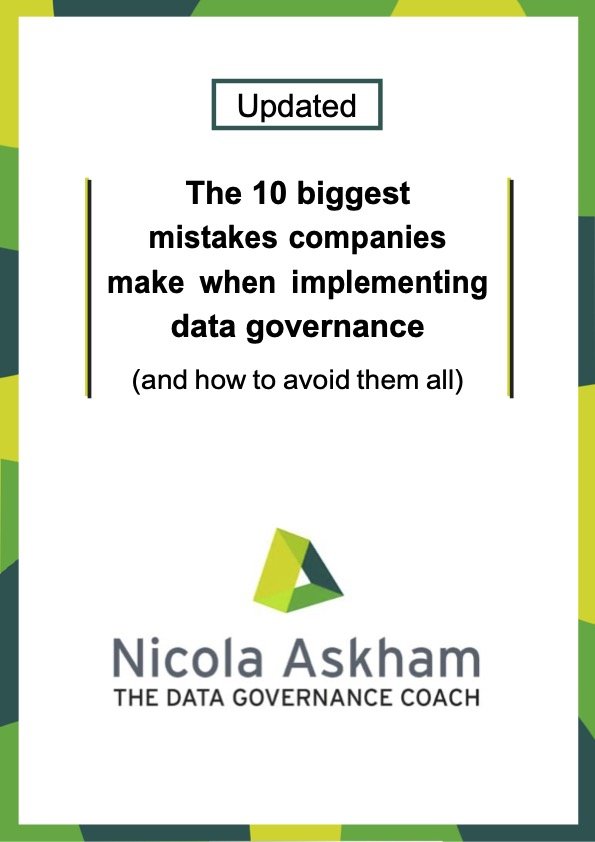Do You Need To Prioritise Your Data?
/This year I've tried to stick to a regular schedule of creating and posting blogs. However, as many of you will have noticed, I failed abysmally a couple of weeks ago. A number of family illnesses and emergencies meant that I was unable to work as many hours as usual. And my blog writing time was spent looking after my husband and other family members.
It wasn't just my blog writing activities that got curtailed. I am very grateful to my clients who very kindly agreed to reschedule planned workshops. They were fantastic and understood that I had to prioritise my family over my work for a short period of time.
What amazes me, though, is that so few people think to take the same approach to their data. After all, is all of your data equal in value? Would it be fair to say that some is “more equal than others”?
What I mean by this is that not all of your data needs to be as proactively managed, monitored and controlled. In fact, to do so, would make data governance a burden or a hurdle to people actually carrying out their day to day activities. This is never the point of data governance. I believe that the point of data governance is to identify the most important data and manage that data proportionately to the value it has to your company.
I first came across this concept when working in the insurance sector. One of their regulations is Solvency II. It primarily deals with the capital adequacy of insurance firms, but at the same time asks for data governance to be put on place over all data being used in the capital adequacy calculations. However, the regulator realised a really important point, in these rather complex calculations, some data is very important, and other data is included just for context. Now, if that latter data is wrong or missing, it would have either no or a negligible impact upon the final calculation. Therefore, the regulator said they didn't expect you to put the same level of data governance in place over that data as opposed to the data which is really important and would actually result in the significantly wrong numbers being calculated.
As soon as I started trying to work this out for the first insurance company I worked with, It made sense to me. I quickly realised that focusing your efforts on the most important data was the right thing to do for data governance. Since that time, I have encouraged every client, regardless of which sector they operate in, to adopt this approach.
Solvency II gave a name for this approach - materialityi.e. it is about identifying your most material data and managing that appropriately. However, be aware that calling it “material data” may not work for you. In fact, I was told in no uncertain terms by a German manufacturing client of mine that the term materiality most definitely does not work if your company uses materials to make something as material data means something else entirely in that context!
We agreed that this would cause confusion rather than be useful. And for that client, and many others since, we have chosen to call it critical data.
Identifying your critical or material data is a very sensible and pragmatic approach, but not necessarily an easy one. You will need to define some criteria for what each level of criticality means so that Data Owners can assess the data that they own against the criteria and decide whether it is critical or not.
There is also the interesting question of how many levels of criticality you need?
My preference is for three levels:
High criticality or high materiality is the data that is the most valuable to your business and would have the most negative impact if it was of poor quality.
Medium criticality or medium materiality is data that is important, but would not have such a large impact if it was of poor quality.
Non-material or Non-critical data is the data that is useful, and perhaps adds context but would not cause great problems if it was not of the best quality.
Over the years, some clients have preferred to go for just two levels of criticality i.e. it either is critical or it isn't. But that feels a bit too much like an all or nothing approach. Data either has lots of controls, standards, data quality monitoring and reporting in place, or it has nothing.
One client, asked me to implement five levels of materiality. I'll be honest, I really struggled to differentiate between the different levels of data governance that you would apply across five categories and ultimately, we rationalised it back to three.
Whatever you call it, and however many levels you decide is right for your organisation, I really would encourage you to try this approach in your data governance initiative. Anyone who regularly reads my blogs will know that I advocate a pragmatic approach. You really can't manage all data perfectly. So why not identify the data that is the most important to your organisation, and manage that appropriately?
Taking such an approach makes it far easier to manage the workload, particularly when you're in the early stages of a data governance initiative. So If you look at the activities on my free data governance checklist, you might decide that some of this needs to be done for all data. But some of the activities you may only wish to do for things that are high or medium materiality data. In this way, you can agree a phased approach of appropriate management on your data according to how important it is to your organisation.








